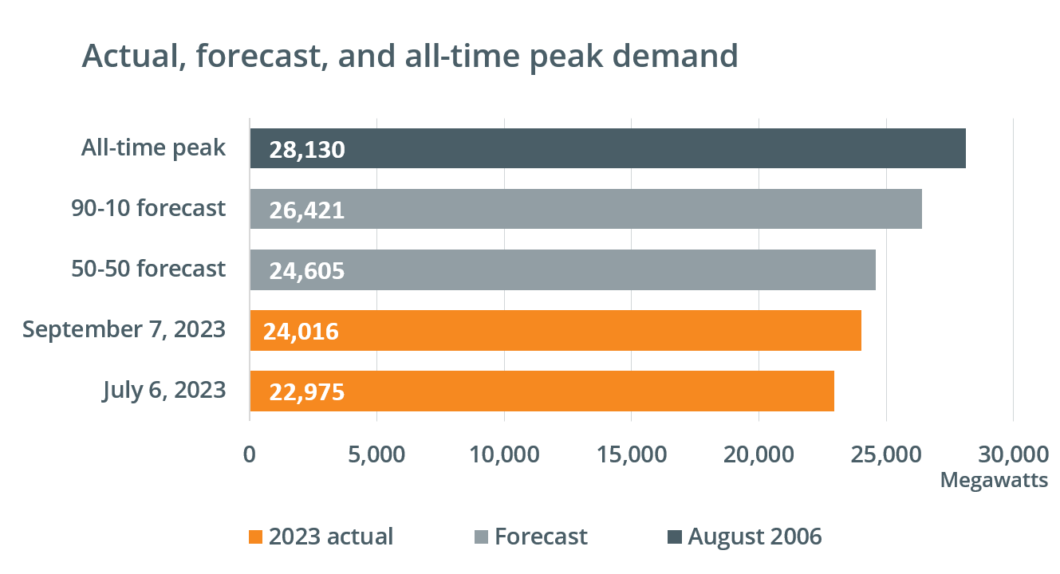Summer 2023 recap: Grid reliability maintained through wildfires and a late season peak
Through warm temperatures and impacts from the Canadian wildfires, New England’s power grid operated reliably in June, July, and August 2023. Wholesale electricity prices fell as the average price of natural gas dropped 71% from the same period last year.
Consumer demand for electricity peaked during the summer months on July 6 at 22,975 megawatts (MW). However, for the first time since 1983, the region saw its annual peak occur outside of this period, with consumer demand reaching 24,016 MW on September 7.

Wildfires impact solar production and electricity demand
In early June, smoke from Canada infiltrated New England, significantly diminishing the region’s solar power production. The haze also resulted in lower temperatures than what weather models forecasted, and the cooler weather led to lower consumer demand. Together, these two factors made forecasting demand for grid electricity quite challenging. Despite these challenges, ISO New England forecasters worked to adjust their modeling to account for the impacts of smoke, and the grid operated under normal conditions.
Managing tight system conditions, including a capacity deficiency
ISO New England successfully managed through tight system conditions during several days this summer, including a capacity deficiency during the evening peak hours of July 5, 2023.
A transmission equipment failure that evening reduced imported electricity, which, in combination with slightly higher than expected consumer demand, resulted in a shortage in the resources required to meet consumer demand and required operating reserves.
To mitigate this situation, system operators implemented Actions 1 and 2 under Operating Procedure No. 4, or OP-4, utilizing a portion of the region’s operating reserves and declaring an Energy Emergency Alert (EEA) Level 1, the lowest of three alert levels. The capacity deficiency was mitigated within 30 minutes, and the region remained in OP-4 for 3.5 hours as peak demand receded and the power system returned to normal operations. At the time OP-4 actions were implemented, net imports were 1,700 MW less than the amount that cleared the Day-Ahead Energy Market. The event resulted in approximately $11 million in penalties under the region’s estimated Pay-for-Performance rules.
Wholesale prices down compared to 2022
Real-time wholesale electricity prices averaged $34.33 per megawatt-hour (MWh) in summer 2023, down 60% from the summer 2022 average of $86.28/MWh.
The drop in wholesale electricity prices was driven in large part by falling natural gas prices, as natural gas-fired resources usually set the price of wholesale electricity in the region. Average natural gas prices for summer 2023 were $2.24 per million British thermal units (MMBtu), a decrease of 71% from summer 2022, when the average price was $7.69.
Resource mix and emissions
During the summer months, natural gas continued to be the primary fuel source for electricity generation in New England, accounting for 61% of the region’s power production. Nuclear power contributed 20%, followed by hydroelectric power at 9%, and grid-connected solar power at 4%. Notably, oil and coal resources did not generate a statistically-significant amount of electricity.
ISO New England estimates carbon dioxide (CO2) emissions associated with the region’s electricity use through an analysis that combines data on electricity generation by fuel type with emissions factors based on Environmental Protection Agency data. CO2 emissions for the summer months decreased by 432,505 metric tons from the previous year, representing a reduction of 4.7%. While emissions for June increased by approximately 7.8% year-over-year, July and August saw reductions of 1.6% and 17.3%, respectively, compared to the previous year.
- Categories
- Industry News & Developments
- Tags
- natural gas, renewable resources, solar, summer, system operations, wholesale prices



